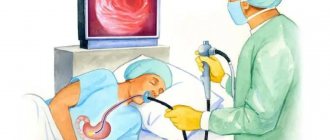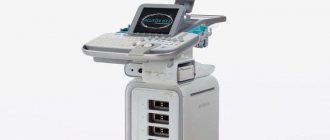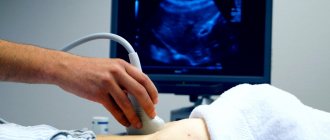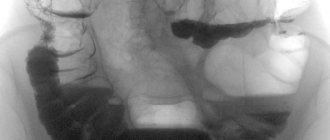At an appointment with a coloproctologist, the doctor must conduct an external examination of the anus and palpation of the lower parts of the rectum. If, as a result, there remains uncertainty about the identified structural changes, anoscopy is prescribed. The doctor explains in advance what kind of study this is and what its significance is, in order to avoid unnecessary stress on the patient and fear of the procedure.
Anoscopy is a technique widely used to visualize suspicious formations in the rectum. The use of a modern anoscope allows you to examine the inner surface of the rectum in the final section at a depth of no more than 10–14 cm. The doctor detects non-palpable structural abnormalities, the exact location, and the nature of the changes. As a result, a decision is made to use other endoscopic diagnostic methods to more accurately determine the cause and essence of the pathology.
It is recommended to undergo an anoscopy examination annually not only if indicated, but also for preventive purposes after the age of forty. This helps to identify the asymptomatic phase of hemorrhoids and rectal tumors.
The importance of endoscopic examinations in colonoproctology
Endoscopic examinations of the intestines help make the correct diagnosis. Data obtained visually (even better with a recording) serve as indisputable evidence of the nature of the pathology of different departments. Endoscopy in coloproctology includes:
- anoscopy;
- proctoscopy;
- sigmoidoscopy;
- colonoscopy (fibrocolonoscopy);
- virtual colonoscopy.
Methods differ in the depth of penetration into the large intestine, accessibility for patients and doctors, capabilities and cost of equipment. They provide objectivity in examining the inner shell.
Anoscopy, as a method of primary examination of the anal canal, is indispensable in identifying:
- hemorrhoidal structures;
- cracks;
- papillomas and condylomas;
- paraproctitis;
- fistulas;
- rectal prolapse.
Every proctologist has the tool. After the procedure, a decision is made on the advisability of using more expensive and voluminous studies.
Endoscopy has become very important for taking biopsy material and for therapeutic purposes. Special equipment of the devices makes it possible to conduct a cytological examination of the obtained samples and distinguish the benign course of the process from a malignant tumor. This radically changes the tactics of treating patients.
Identification of the source of bleeding and polyps is accompanied by simultaneous removal and coagulation of damaged vessels. Injecting medications directly into the site of inflammation makes it possible to reduce to a minimum the path of medications through the gastrointestinal tract and bloodstream, sparing other organs.
Anoscopy is indispensable when removing hemorrhoids using minimally invasive methods (application of latex rings, vascular ligation, sclerotherapy, electrocoagulation).
Endoscopic procedures have become firmly established in the practice of coloproctologists. For adult patients, they are performed on an outpatient basis. Methods of short-term anesthesia have been developed for children. Much hope is placed on the virtual method of examining the intestines by swallowing a “pill.” So far, research is rarely carried out in the Russian Federation and is inaccessible due to its high cost.
How does anoscopy differ from other diagnostic methods?
Examination of the rectum - endoscopy. It includes all methods of examination inside the rectum in order to detect diseases. Anoscopy is an examination of the rectum at a distance of 5–10 centimeters.
This type of research:
- studies the cause of anal fissures;
- finds hemorrhoids;
- takes a piece of tissue for testing (biopsy).
Differences between endoscopy instruments.
| Tool | Description | Preparation |
| Anoscope | Anascope is a tube from 5 to 7 centimeters. | Preparation for the analysis occurs on the day of the procedure: it is necessary to do an enema. |
| Proctoscope | The proctoscope is 10 centimeters long. Has the ability to examine a section of the rectum at a distance of up to 13 centimeters and make an injection inside the intestine, if necessary. | When preparing for proctoscopy, you should stop eating bread, fruits and legumes the day before the procedure. In the morning you can drink tea and eat a light breakfast. Also do an enema 1-2 hours before the procedure. |
| Proctoscope | The instrument has a bulb for supplying air to the rectum: it straightens the walls for a better view. There are two types of rectoscope:
| Preparation for rectoscopy is more complicated. In addition to the enema before the procedure, you must follow a special diet for 4 days. |
Indications and contraindications
Anoscopy can be performed as a preventative measure for people at risk. It is most often used for the following:
- vague pain in the anal canal;
- wetting of the skin around the anus due to the secretion of mucus, blood, and pus;
- long-term bowel movements (constipation, diarrhea);
- sensation of a foreign body in the anus;
- signs of fistulas, rectal fissures;
- prolapse of hemorrhoids;
- the need to exclude neoplasms in the lower part (polyp, tumor, condylomas);
- suspected infection with a lesion in the rectum.
An absolute contraindication is an acute inflammatory process, which creates conditions for destruction and traumatization of the intestines by the tube. To eliminate pain during the procedure, local anesthesia is first administered.
Relative contraindications include:
- narrowing of the anal canal due to adhesions;
- acute infectious inflammation with fever;
- thrombosis of the hemorrhoid;
- paraproctitis, acute stage of Crohn's disease;
- trauma to the rectum and anus;
- large tumors causing rectal stenosis;
- burn of the mucous membrane of the III–IV degree of chemical or thermal origin;
- chronic anal fissures in the acute phase.
Important! Contraindications are called “relative” because if there is a need to examine the rectum due to a danger to the patient’s life, anoscopy is performed with the utmost caution. Similar reasons are caused by the contraindication of the procedure in severe patients with cardiac and respiratory failure.
Treatment of diseases detected by anoscopy
After anoscopy, the proctologist establishes an accurate diagnosis and draws up a treatment plan for the identified disease. Doctors at the proctology department adhere to the recommendations of the European Association of Proctologists, but take an individual approach to the choice of treatment method for each patient. Conservative therapy is carried out using the latest drugs that are effective and have a minimal range of side effects.
Many interventions are performed under anoscope control. Proctologists at the Yusupov Hospital use the latest equipment from leading global manufacturers. It allows not only to examine the rectal mucosa, but also to remove the tumor. The operation is performed through the anus, without violating the integrity of the skin of the anterior abdominal wall and perineum. Severe cases of rectal diseases are discussed at a meeting of the Expert Council. Professors, doctors of medical sciences, and doctors of the highest category collectively select the optimal method of treating the patient. If the results of anoscopy are not enough to establish an accurate diagnosis, the patient is examined using sigmoidoscopy, colonoscopy, magnetic resonance and computed tomography.
Modern approaches to the treatment of anal fissure
Anal fissure is one of the most common human diseases. Proctologists at the Yusupov Hospital detect it in 11-15% of patients suffering from diseases of the rectum and perianal area. The disease predominantly develops in young and middle-aged people; women are more often affected.
Proctologists at the Yusupov Hospital perform anoscopy in the presence of symptoms of acute anal fissure after pain relief. During anoscopy, the doctor determines a longitudinal defect of the mucous membrane with clear edges and a bottom. In the chronic course of the disease, the edges of such an ulcer become denser and thicker, especially in the far part of the crack. In this place, a polypoid, connective tissue thickening is formed, which is called the “sentinel tubercle.” In the proximal region, at the level of the dentate line itself, sometimes during anoscopy the doctor determines the presence of a hyperplastic anal papilla.
A true anal fissure is a traumatic tear in the wall of the anus, which is accompanied by severe spasm of the sphincter and severe pain. Unlike various kinds of superficial tears and abrasions, which can be localized along the entire circumference of the anus, the crack is always located only along the midline at 6 o'clock on the dial (coccygeal side). Less commonly, a proctologist finds, during anoscopy, a mucosal defect on the anterior wall of the rectum - twelve o’clock on the dial with the patient in the supine position.
During an anoscopy, the doctor performs a biopsy. During a histological examination, the morphologist finds replacement of the fibers of the subcutaneous part of the external anal sphincter with connective tissue. With a long course of the disease, this process leads to relaxation of the sphincter.
In the treatment of patients with anal fissure, proctologists at the Yusupov Hospital use many techniques:
- Excision of the crack;
- Various types of sphincterotomy;
- Alcohol-novocaine blockades;
- Administration of botulinum toxin;
- Laser coagulation of cracks.
Despite the use of modern treatment methods, relapse of the disease, according to various sources, occurs in 15-45% of patients. The decrease in the quality of life of patients is affected by the high incidence of specific postoperative complications: anal sphincter insufficiency and cicatricial strictures. Long-term positive results are achieved with complex pathogenetically based treatment. Doctors at the proctology department use the drug treatment regimen recommended by the European Association of Coloproctologists. It includes laxatives, sitz baths, ointments and suppositories with local anesthetics.
In the acute form of the disease, patients with anal fissure are treated with drugs of immunomodulatory action. An effective and alternative treatment method for patients with chronic anal fissure is excision of the anal fissure with suturing of the postoperative wound and formation of a drainage canal with lateral subcutaneous sphincterotomy. Positive long-term results allow doctors at the proctology department to obtain a comprehensive method of treating patients with anal fissure. It consists of the use of immunomodulatory drugs Posterizan and Viferon and surgical intervention - excision of the anal fissure with suturing of the postoperative wound and formation of a drainage canal in combination with lateral subcutaneous sphincterotomy. The use of immunomodulatory drugs by doctors at the proctology department in the preoperative and postoperative periods allows for early rehabilitation of patients, reducing the risk of developing postoperative complications and the frequency of disease relapses.
Preparation for the procedure
The need to prepare for the procedure is related to ensuring a sufficiently clear picture of a good bowel cleansing. If the abdomen becomes distended from gas, the patient experiences understandable discomfort. To prepare the rectum, it is enough:
- for 1-2 days, avoid eating fatty foods, pickles, legumes, hot sauces, fresh vegetables and fruits, cabbage;
- do a water enema twice the night before and repeat early in the morning (emptying should occur 2 hours before the test);
- instead of an enema, you can use laxatives such as Fortrans, Flit-soda once, they must be taken 24 hours in advance strictly according to the schedule;
- If you do not have time to take a laxative, then to prepare for an anoscopy examination, it is enough to use a standard Microlax microenema, inject the drug into the rectum early in the morning on the day of the procedure, bowel movements will appear in 20 minutes.
Complications
Anoscopy is a safe procedure with no obvious side effects or complications.
Possible complications include:
- perforation of the rectum (more often possible if the patient resists examination). In this case, the anoscope may damage the wall of the anal canal;
- allergic reactions (to the used lubricant, anesthetics, sedatives).
Anoscopy is an effective examination with low cost. The price of the procedure in Moscow starts from 700 rubles to 2000.
Order of conduct
Depending on the patient’s condition, the doctor chooses a position for the procedure:
- lying on your back - this is how seriously ill patients are examined even if there is a gynecological chair in the office;
- the knee-elbow position (Trendelenburg position) is convenient for people with a large belly;
- lying sideways on a high couch with your knees drawn to your chest.
Before anoscopy, the proctologist performs a digital examination of the intestine. It allows you to preliminarily focus on the expected pathology, palpate the sacrum, prostate in men, uterus in women.
The procedure must be performed with a disposable or sterile instrument, and the doctor wears gloves. Unpleasant sensations when inserting the tube are relieved by pre-lubricating the end with Vaseline or lidocaine gel. The device is inserted without obstacles slowly in a circular motion and moves deeper. Then the mandrin is pulled out of the tube and examined.
Proctologists have a standard form for recording local changes according to the diagram of a watch dial. With the patient in the supine position, it involves dividing the circumference of the anus into zones. The “XII o’clock” point is located along the seam of the scrotum in men, under the opening of the vagina in women. Accordingly, “VI o’clock” is opposite the coccyx. The doctor describes the detected changes in the area of a certain hour.
The examination lasts about 20 minutes. If additional tests or treatment procedures are required, more time will be required. The anoscope is gently removed from the intestine. The patient is asked to go to the toilet and clean the anus with a damp cloth.
Reviews from patients and doctors
Reviews from people who have undergone anoscopy confirm the absence of pain or the need for anesthesia and good tolerability.
| Valery: “I ended up seeing a proctologist by chance without an appointment; I was brought by the doctor by the hand. sister from the prevention room. Along the way she scared me with various diseases. The doctor turned out to be a completely approachable man. He warned me to be patient. Indeed, it was not much fun, but the inspection went quickly. I didn’t do any preparation, although I didn’t eat in the morning.” |
| Tatyana Vladimirovna, proctologist at the clinic: “The networks often confuse anoscopy and proctoscopy, but they are the same thing. It all depends on the length of the tube of the device. Sometimes you come across nervous patients who groan when you touch their skin. I tell therapists who write referrals that it is better for them to take sedatives in advance. According to my observations, it is very rare to use dicaine ointment.” |
| Inna: “I think contact with a doctor matters. This also applies to gynecologists. A rude doctor evokes fear in response. And the one who persuades you like a child helps you endure the examination. I'm lucky. I was so embarrassed by the male doctor, but respect and sympathy helped.” |
Diagnostic methods in coloproctology spare the patient’s feelings and the rectum as much as possible. Training requirements should be taken into account to avoid repetition due to unreliable results.
Technique
Typically, the doctor will first perform a digital rectal examination to ensure that there is no mass or tissue obstructing the anal canal that could be damaged during insertion of the device. There is insufficient evidence to comment on the effectiveness of pre-procedural topical lidocaine for pain relief during anoscopy, but in the absence of a known allergy to lidocaine, many practitioners consider this a reasonable measure to adopt.
A water-soluble lubricant is applied to the anoscope itself before insertion to facilitate insertion. This can be accomplished by using a local anesthetic as the actual lubricant, thereby allowing the lidocaine to be distributed along the path of the anoscope before insertion. Typically, the device is inserted with the obturator in place, which is then removed, allowing the examiner to visualize the anal canal and distal rectum while slowly withdrawing the anoscope. In the case of slotted anoscopes, which allow only part of the mucosa to be visualized at a time, the obturator must be reinserted before repositioning or rotating the device due to the discomfort associated with applying traction to a segment of tissue that protrudes into the slotted segment.








